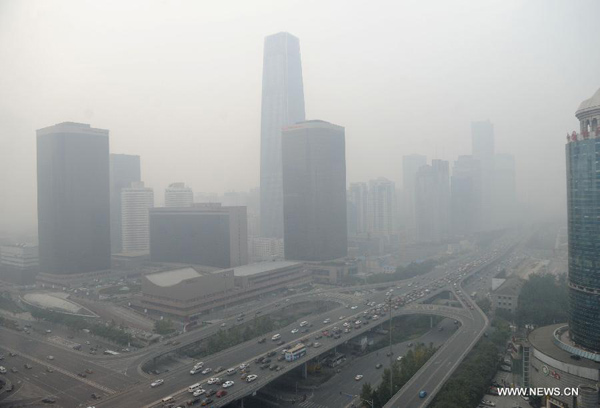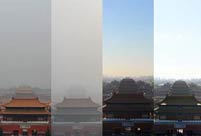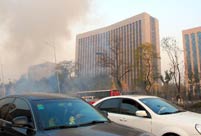 |
| Buildings are blanketed in heavy smog near Guomao Bridge in Beijing, capital of China, Oct. 28, 2013. (Xinhua/Luo Xiaoguang) |
No matter what she did to try and protect her 3-year-old son from Beijing's notoriously serious pollution, such as taking him out of kindergarten, putting dozens of plants around the home, or spending huge amounts of money on air purifiers, Li Jing has had to admit that her efforts have been in vain.
One week after being "grounded," her son started coughing.
This year has seen record numbers of smoggy days around the country, with at least 10 out of 23 provinces issuing red alerts. With no sign of the air getting cleaner in the short term, residents like Li have been forced to find other ways to cope with the pollution.
"I learned how to cook soup for my family," she told the Global Times. "I found a recipe for dry vegetable soup that is said to prevent lung cancer."
This came in the wake of the World Health Organization (WHO)'s recent announcement that polluted air kills millions of people every year. A week ago, an 8-year-old girl became the country's youngest lung cancer sufferer. Doctors linked her disease with high levels of PM2.5, small particles less than 2.5 micrometers in diameter that can penetrate deep into the lungs.
The repeated news coverage of high PM2.5 levels has worried many residents and raised awareness of rising pollution levels.
"We leave it to the government to clean up the outdoor air, but we take responsibility for making the indoor air cleaner," Li said.
Indoor monitoring
Beijing has long suffered from air pollution. Heavy reliance on coal, millions of motor vehicles and dust storms from neighboring provinces have all contributed to the problem. Earlier in January, the capital city saw a record PM2.5 reading of over 600 micrograms per cubic meter, which was more than 30 times above the level judged safe by the WHO.
Last month, the city announced the toughest smog emergency measures yet: If the PM2.5 level exceeds 300 micrograms per cubic meter for three days in a row, schools would be suspended, construction sites ordered to halt work, private cars limited to using roads on alternate days and factory emissions cut.
With no sign that these measures could decrease the smog any time soon, many residents have started paying attention to the indoor air quality, as they usually spend up to 70 percent of their time either at home, in the office or in public areas.
Earlier this year, CCTV anchor Zhang Quanling posted on Weibo, China's version of Twitter, about her recent visit to the National Museum of China, saying she was surprised to find that the indoor PM2.5 level was only 16.
"I was shocked to find that the PM2.5 inside the museum was only 16, while outside it was almost 1,000," she wrote. "From now on, I will bring my family to the museum on polluted days."
Staff at the museum told the Global Times that the credit should go to their new fresh air filtration system, which is designed to protect the exhibits.

 Luxury-cars parade held in Dubai
Luxury-cars parade held in Dubai Special forces take tough training sessions
Special forces take tough training sessions Fire guts 22-storey Nigeria commercial building in Lagos
Fire guts 22-storey Nigeria commercial building in Lagos A girl takes care of paralyzed father for 10 years
A girl takes care of paralyzed father for 10 years A record of Beijing air quality change
A record of Beijing air quality change In pictures: explosions occur in Taiyuan
In pictures: explosions occur in Taiyuan Live a harmonious life in Pu'er, SW China
Live a harmonious life in Pu'er, SW China Weekly Sports Photos
Weekly Sports Photos Gingko leaves turn brilliant golden yellow in Beijing
Gingko leaves turn brilliant golden yellow in Beijing Maritime counter-terrorism drill
Maritime counter-terrorism drill Loyal dog waits for master for six months
Loyal dog waits for master for six months The catwalk to the world of fashion
The catwalk to the world of fashion  China in autumn: Kingdom of red and golden
China in autumn: Kingdom of red and golden National Geographic Traveler Photo Contest
National Geographic Traveler Photo Contest Living in an urban village: 'Iron-digger' Xiong Sansan
Living in an urban village: 'Iron-digger' Xiong SansanDay|Week|Month